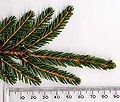| Picea orientalis | |
|---|---|
 | |
| Scientific classification | |
| Kingdom: | Plantae |
| Clade: | Tracheophytes |
| Clade: | Gymnospermae |
| Division: | Pinophyta |
| Class: | Pinopsida |
| Order: | Pinales |
| Family: | Pinaceae |
| Genus: | Picea |
| Species: | P. orientalis |
| Binomial name | |
| Picea orientalis | |
 | |
Picea orientalis, commonly known as the Oriental spruce [2] or Caucasian spruce, is a species of spruce native to the Caucasus and adjacent northeast Turkey.




